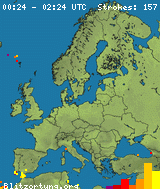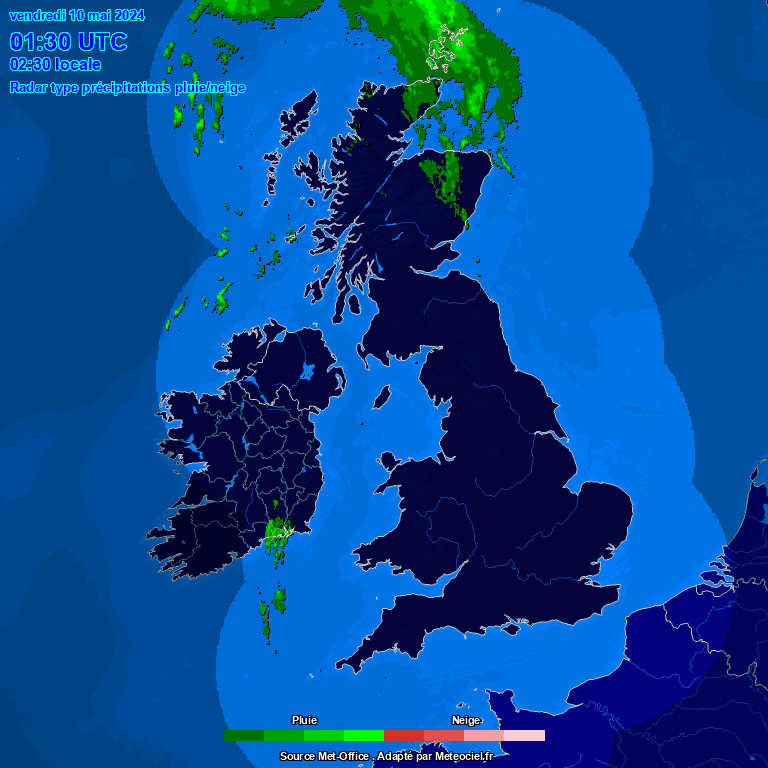Anemometor Heater
|
Since I've had my Oregon Scientific WMR928 weather station I have had the odd issue with the wind speed freezing during cold weather, (frost and snow). A couple of days ago I came up with an idea for a heater and did some experimenting with a spare anemometer and came up with this idea. It uses 2 wire-ended filament type 12V, 0 08A, 0 96W bulbs, the thinnest wire that will handle the bulbs and a Kemo Temperature Thermostat switch. This setup can run off a 12v battery or a 12v mains PSU. It delivers just the right amount of heat to eliminate any ice and snow build up. You can set the Kemo switch to cut in at what ever temperature suits you, I will have it set at around 2oC once it warms over this temperature then it will turn off the bulbs... Here's how I did it....
Items Needed:
Total cost should be no more than £30 |
 This
section is so you can see what thickness the cable must be! Believe me
when I say it needs to be thin.... Ok, Lets start, on the mounting end,
remove the 8 screws holding the cover, then remove the 4 screws holding
the PCB, then remove rubber water stop and the 2 screws holding the
cable down and the single screw and red/brown washer, this is were you
need to feed the cable, it has to follow the existing flat 6 core cable!
now you can see why it needs to be the thin stuff, perhaps removing the
outer casing off the cable will help there, its an option if needs be.
You can put a couple of screws back in for now just to hold it together
whilst we move on...... Now might be a good time to give it a clean.... This
section is so you can see what thickness the cable must be! Believe me
when I say it needs to be thin.... Ok, Lets start, on the mounting end,
remove the 8 screws holding the cover, then remove the 4 screws holding
the PCB, then remove rubber water stop and the 2 screws holding the
cable down and the single screw and red/brown washer, this is were you
need to feed the cable, it has to follow the existing flat 6 core cable!
now you can see why it needs to be the thin stuff, perhaps removing the
outer casing off the cable will help there, its an option if needs be.
You can put a couple of screws back in for now just to hold it together
whilst we move on...... Now might be a good time to give it a clean.... |
| You need to loosen the tightening screws and remove the direction and the speed units as show in the 1st image below, leaving the housing as shown in the 2nd image, Then you need to remove the nut and washer as shown in image 3 below, then remove the screw that is holding the whole housing to the mounting pole and gently pull the housing off the pole, as shown in image 4 below... |
| Now look in the hole where the pole used to be and you will see a press in clip, See 1st image below, using a screwdriver, push in the clip and push up and the same time so that you are releasing the inner sleeve, gently pull out the inner sleeve and the direction sensor will come out too, you can then gently pull out the small PCB that has the reed switch on it, NOTE: Be careful when pulling it out as the reed switch and wires are a little delicate. Now its all stripped down and ready for the wire with the bulbs attached. You really need to attach the bulbs to the wire as shown in image 3 below, the reason for this is so that you can have one bulb at the very bottom of the housing and one behind the small PCB. At this point you can insulate the back of the PCB where the bulb will go and the wires for the direction sensor as shown in image 2. |
| It will be easier to route the wires by removing the screw that's in image 1 below and gently pulling the pipe out, Now you need the thread the wire into the housing and out through the SAME hole the flat 6 care cable is through, then through the pipe, pull it all through so your left with just the bulbs as shown in the 2nd image below (used thicker wire to show you), Now carefully refit the PCB holder holding the wires out of the way, make sure it goes all the way to the bottom else the other sleeve will not click into place. Now carefully push one bulb OVER the PCB and down to the bottom of the housing to the metal plate that holds the speed sensor bearing, then push the other bulb behind the PCB and pulling any spare cable through the hole so there is NO spare cable inside the housing at all. see image 3, you can see the bulb behind the PCB but the 1st bulb is now hidden. |
 Now
to refit the direction spindle and sleeve, note that the direction
spindle unit has a notch, its imperative that this fits into the hole
inside the sleeve, once you have the notch in the hole replace the
washer and bolt, now you need to gently twist the sleeve so that the
excess wires coil back into the sleeve and once done gently slide it
back in to the housing but making sure no wires are being pinched, pull
it back out to check if your unsure, if no wires are being pinched and
the bottom sleeve is in place 100% then the top sleeve should slide into
place and the clip that you released should not click back into its
hole. That's the housing part all done, don't fit the pole yet, if I was
you I would now check the setup to make sure it all works, temporarily
connect the Temperature switch following all the instructions that came
with it, any problems with the wiring then contact me from the menu on
the left. Adjust the switch to set off the relay and see if the bulbs
light up by looking into the hole where the pipe goes, if its working
then disconnect the switch and carry on.... Now
to refit the direction spindle and sleeve, note that the direction
spindle unit has a notch, its imperative that this fits into the hole
inside the sleeve, once you have the notch in the hole replace the
washer and bolt, now you need to gently twist the sleeve so that the
excess wires coil back into the sleeve and once done gently slide it
back in to the housing but making sure no wires are being pinched, pull
it back out to check if your unsure, if no wires are being pinched and
the bottom sleeve is in place 100% then the top sleeve should slide into
place and the clip that you released should not click back into its
hole. That's the housing part all done, don't fit the pole yet, if I was
you I would now check the setup to make sure it all works, temporarily
connect the Temperature switch following all the instructions that came
with it, any problems with the wiring then contact me from the menu on
the left. Adjust the switch to set off the relay and see if the bulbs
light up by looking into the hole where the pipe goes, if its working
then disconnect the switch and carry on....
|
 You
can now fit the pole back in to the anemometer hosing now, again,
its imperative that you DO
NOT pinch the
wires and make sure the holes line up and that there's a clear line of
sight for the screw to be fitted without harming the wires inside, if
there is not clear line of sight then pull it off again and refit it
until your happy the screw will not damage the wires. If you haven't
already done so, remove all screws again so you can lift up the PCB
that's in image 1, now remove the melted glue from the hole where the
flat 6 core wire comes through and thread your new wire following the
path of the flat 6 core cable, making sure its under the big o-ring and
all the way out of the housing, its this part that will let you know if
your wire is thin enough. Make
sure you leave about 8 inches of slack wire inside the pipe just
in case you need to do any maintenance on the other end in the future,
if you don't you will not be able to pull the other end apart without
disassembling this section again. If your happy with it all then lightly
coat the o-ring with Vaseline/Petroleum jelly, do the same with the
rubber water stop you pulled out earlier, this is to help repel any
water/moisture, then gently screw down the PCB, and the 2 wire stops and
refit the case cover, any screws left over? no doubt pmsl... That's
about it, refit the temperature switch and use a water proof housing for
it, you can extend the temperature probe by a MAXIMUM of
1 meter so the switch unit will need to be close to the anemometer, I
would also seal the probe, I'm sure it says to do that anyway, just
follow the instructions that comes with the switch and you wont go far
wrong. You
can now fit the pole back in to the anemometer hosing now, again,
its imperative that you DO
NOT pinch the
wires and make sure the holes line up and that there's a clear line of
sight for the screw to be fitted without harming the wires inside, if
there is not clear line of sight then pull it off again and refit it
until your happy the screw will not damage the wires. If you haven't
already done so, remove all screws again so you can lift up the PCB
that's in image 1, now remove the melted glue from the hole where the
flat 6 core wire comes through and thread your new wire following the
path of the flat 6 core cable, making sure its under the big o-ring and
all the way out of the housing, its this part that will let you know if
your wire is thin enough. Make
sure you leave about 8 inches of slack wire inside the pipe just
in case you need to do any maintenance on the other end in the future,
if you don't you will not be able to pull the other end apart without
disassembling this section again. If your happy with it all then lightly
coat the o-ring with Vaseline/Petroleum jelly, do the same with the
rubber water stop you pulled out earlier, this is to help repel any
water/moisture, then gently screw down the PCB, and the 2 wire stops and
refit the case cover, any screws left over? no doubt pmsl... That's
about it, refit the temperature switch and use a water proof housing for
it, you can extend the temperature probe by a MAXIMUM of
1 meter so the switch unit will need to be close to the anemometer, I
would also seal the probe, I'm sure it says to do that anyway, just
follow the instructions that comes with the switch and you wont go far
wrong.
IMPORTANT NOTES:
When wiring up the
switch (its normally open) you have to wire it up so its now normally
closed, the reason for this is because in normal use the switch is used
for setting off the relay once it reaches ahigher temperature,
but we want it to activate once it reaches around 2oC (lower
temp) so you must wire it so its normally closed, now the odd part. When
used in the normally open way, the switch activates the relay and the
LED on the switch comes on to let you know its switched, well because of
the need to wire it normally closed, the LED is permanently on until it
switches then it
turns off, i think it was an oversight at the manufacturing stage but it
took me around a day to figure out it still works as needed using the
fridge!
This is the completed power source switching unit, input is from a 12v battery housed in a waterproof container
|




















